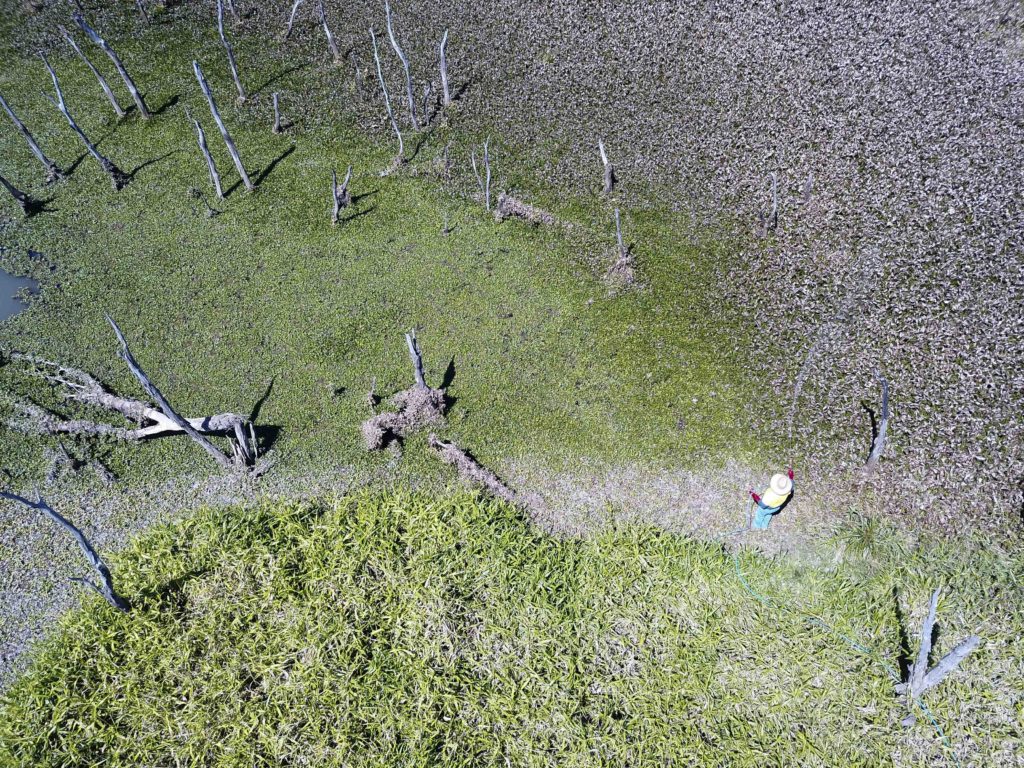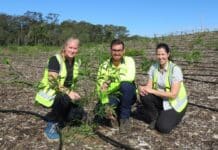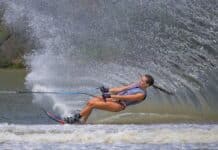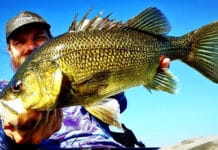
Bundaberg Regional Council’s land protection team is taking to the waterways to rid the region of aquatic weeds, targeting water hyacinth and hymenachne.
The ongoing program aims to reduce the presence of invasive species in the region’s waterways as part of the wider Wide Bay Burnett Regional Organisation of Councils’ (WBBROC) Operation Aquatic.
Childers Land Protection Officer Spencer Katt recently joined contractor Peter Brightwell in the Burnett River to treat water hyacinth and hymenachne and scout for rubber vine locations.
“We run the rivers and look out for these pest plants,” Spencer said.
“If they get out of control it’s going to be harder to control in the future, so we keep monitoring it and taking out what we can see.”
Aquatic weeds have the ability to cause significant impacts to the region’s environmental, social and economic values. They can be spread by water, human and animal movements.
Spencer said leaving water hyacinth to get out of control was not an option.
“It can take bridges out if it’s banked up and there’s a lot of it; it can do structural damage; and they choke up the waterways.”
Peter said the two aquatic weeds could be found in the Burnett River and the Kolan River.
“We are on top of it, we just need constant monitoring of the riverways,” he said.
“Water hyacinth does take a lot of moisture out of the river, just as much as evaporation.
“The water hyacinth can actually double its quantity within about 10 days.”
He said hymenachne was an introduced species.
“Stock will feed on the hymenachne and that can get out of control really quickly if we don’t keep on top of it.
“The hymenachne will actually transfer through the river by stock walking through it, eating it, breaking it down.”
Land protection team tackle aquatic weeds
Peter said it required regular monitoring to keep the presence of aquatic weeds to a minimum.
“We try to do a cycle of the river every month or so to make sure we are controlling it,” he said.
“If we leave it too long it will get out of control.
“At Sandy Hook today, it’s pretty pristine at the moment and we’d like to keep it that way.”
The spread of the plant is usually from unsuspecting locals.
“It could be hooked up underneath [a boat],” Spencer said.
“He might put the boat in here then go down further and put it in somewhere else and there could be some material left on the trailer.”
However Spencer said it could also be spread by residents cultivating it on private property.
In a recent example he said he had seen water hyacinth grown in a dam at Childers.
“They thought it was a good thing because it was growing so quick.
“They were using it as mulch.
“They were pulling it out and putting it around their gardens and it would come back that quick so they’d keep raking it off and putting it in their gardens.”
Spencer said the homeowners happily cooperated with requests to remove the weed as soon as they knew what it was.
While traversing our waterways officers also keep an eye out for land-based invasive species like the rubber vine.
Identifying the plants from the boat using binoculars Spencer said officers either treated the pest plant immediately or, when on private property, marked its location using a special program on a tablet.
“When we see rubber vine we mark it with a point and just fill in the relevant information,” he said.
“And then we take it back to the office and download it and it comes up on our mapping at work and then we can send a picture of that to the landholder so that they know exactly where to find it.”
When on public land the officers simply wrestle with the thick scrub to access and treat the plant.
“It can be pretty wild going that’s for sure,” he said.
“We could walk kilometres along the river because you can’t access it any other way.”
Operation Aquatic targets weeds in Wide Bay Burnett
All WBBROC partners are working hard to target aquatic pests as part of Operation Aquatic.
“All the Councils are getting together and talking and sharing information and resources to help each other and lend a hand,” Peter said.
“The more people we have involved in that group the better it is for our aquatic weeds or weeds in general as well.
“As for river systems, it’s very important because everything comes down to Bundy.
“The Burnett is a vast body of water so anyone above the water system that can help the weeds there it will prevent it from coming down here.”
It's not the first time neighbouring Councils have teamed up to target pest plants with the Bundaberg and North Burnett Councils recently combining to combat the invasive honey locust plant.
Anyone who believes they have seen a species of invasive weed can report it to Council’s land protection team on 1300 883 699.
“We can send out a land protection officer to identify the weed,” Peter said.
“We have officers in Childers, Gin Gin and two in Bundaberg and they’re always available to come out and identify that weed for you to let you know if it is an invasive pest.”








Can they take a look at the lakes in Baldwin Swamp which are clogged with weed? Saw a moorhen walking across the lake the other day…
Comments are closed.